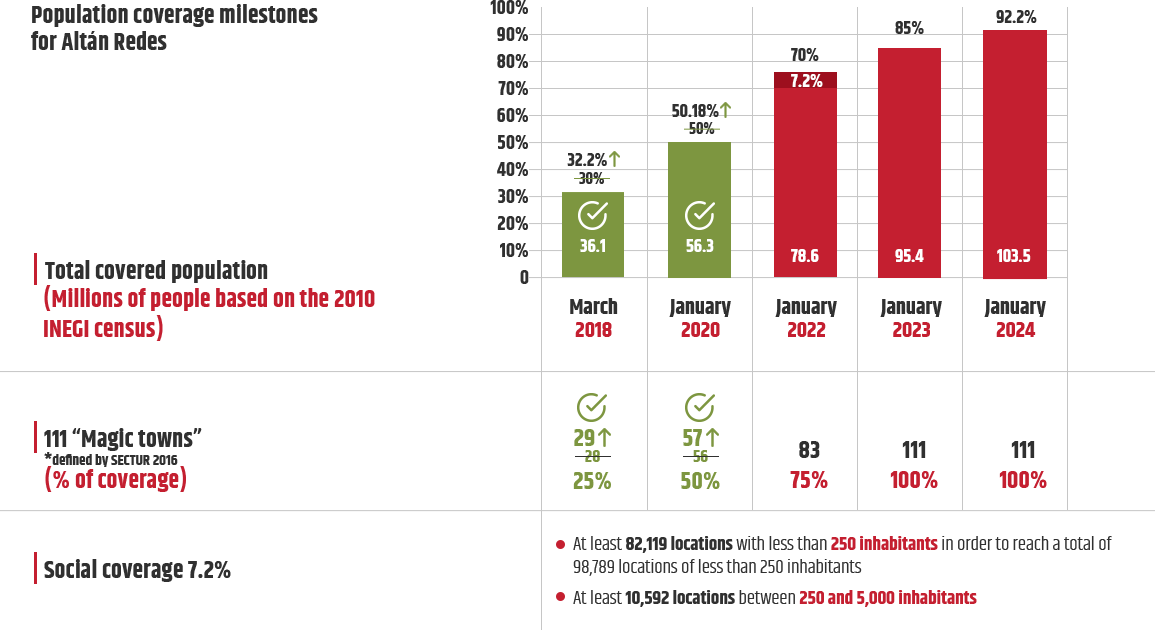Red Compartida, Mexico
26.08.2020Introduction
One of the key issues that countries face as they migrate to the digital economy is to provide incentives for investment in the necessary broadband infrastructure. Some countries have adopted the model of a single, national broadband network. The example of Mexico is especially interesting as the Red Compartida (“shared network”) project is focused on delivering a national broadband mobile (4G-LTE and 5G) network.
Why a shared network?

Source: IFT.
Mexico has never managed to achieve effective competition in telecommunications service provision. América Móvil has retained a market share of more than 60 per cent in the retail mobile market (through its subsidiary, Telcel) and more than 50 per cent in the retail fixed broadband market (through its subsidiary, Telmex-Telnor). Alternative service providers have struggled.
In 2013, the telecommunications sector in Mexico was reformed in order to encourage competition, enable investment including direct foreign investment, and strengthen the regulatory framework. One of the main objectives of the reform was to increase access to high-quality telecommunications and broadcasting services to create a vibrant digital economy. To this end a new type of shared network was created. The principal aim of Red Compartida was to create a nationwide network to provide a vehicle for mobile virtual network operators (MVNOs) to enter the market, thus increasing consumer choice, improving quality of service and, ultimately, overcoming the digital divide between urban and rural areas.
Red Compartida was established as a wholesale-only network offering equal access to any service provider, so that effective competition could be established at the retail level. It was required to cover at least 85 per cent of the population, with at least 15 per cent of its population coverage in communities of less than 10 000 people. The project works alongside another initiative, Red Troncal, that similarly aims to offer equal access to a national backbone fibre network, based on the 25 000 kilometre fibre network of the state energy company, CFE.
Progress to date

Source: Altán.
The network operator, Altán Redes, was chosen in January 2017 after a competitive tender process. It was awarded a 20-year concession in January 2017, renewable for a further 20 years, to design, finance, deploy, and construct a wholesale 4G mobile network. The public-private partnership (PPP) agreement gives Altán exclusive use of the 700 MHz spectrum range (Band 28) and access to Red Troncal, the national fibre backbone network. All other financing has to be raised from the private sector. Altán has raised USD 750 million of equity and USD 1 500 million of loans, including funds from various national and regional banks and from Altán’s technical partners (Huawei and Nokia).
The network is entirely based on 4G-LTE technology, with full virtualization for easy migration to 5G. It is based on an open network architecture, with full interconnection with other networks in Mexico. There are currently over 60 service providers using the network.
Red Compartida met its obligation of covering 50 per cent of the population by January 1, 2020; the next target is 70 per cent population coverage by January 1, 2022, with Altán aiming for 92.2 per cent coverage in 2024. In many areas, Red Compartida is the only available broadband network. A particular focus is on serving the country’s 111 “Pueblos Magicos” (magical towns) which are communities of under 20 000 population that have special cultural, natural, or touristic significance, but many of which have not previously had broadband access.
How is it regulated?
Under the terms of the PPP agreement, Altán is not permitted to sell directly to the public but is required to make available a non-discriminatory wholesale reference offer for access to its network.[1] Only retail service providers such as mobile network operators and MVNOs are permitted to access the Red Compartida. The reference offer has to offer guarantees of service quality, in terms of uplink and downlink speed, latency, and network availability. A range of different service offerings are permitted, but all of them have to be made equally available to any service provider. The reference offer was approved by the national regulator, Instituto Federal de Telecomunicaciones (IFT), in February 2018.
Best practice lessons
Access to infrastructure is a major source of competitive advantage in retail telecommunications markets. It can be hard for regulators to enforce infrastructure sharing by dominant companies, such as América Móvil in Mexico, on commercial and technical arrangements that facilitate retail competition. Red Compartida provides an alternative solution:
- By creating a new wholesale-only company it provides a natural environment for infrastructure sharing to take place.
- By allowing access to public assets such as backbone fibre and radiofrequency, wholesale prices can be attractive to retail service providers.
- By requiring the publication of a Reference Access Offer, transparency and non-discrimination are achieved.
- By setting coverage requirements, digital inclusion is facilitated.
Although Red Compartida is still in an early phase of its development, and it remains to be seen how much impact it ultimately has on digital services competition, it provides a template that other countries would do well to consider.
Endnotes
- The reference offer is available (in Spanish) at available here. ↑
References
OECD (Organisation for Economic Cooperation and Development). 2017. OECD Telecommunication and Broadcasting Review of Mexico, 2017. Paris: OECD. https://www.oecd-ilibrary.org/docserver/9789264278011-en.pdf?expires=1588665168&id=id&accname=guest&checksum=A4C38E6608793A3D1A100A2599F34F3C.
Last updated on: 19.01.2022